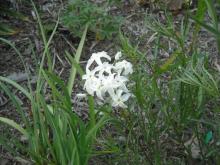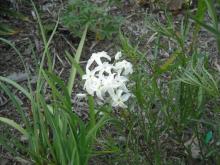Does anyone know anything about the current status of Ron Ratko and his seed company, Northwest Native Seed? Any information would be VERY helpful. Thanks in advance.
Comments
Re: Ron Ratko/Northwest Native Seed
That's a real shame as we got some good stuff from him! :'(
Doubly tragic as Rocky Mountain Rare Plants has also shut down :'( :'(
I don't begrudge them the time off as it's not an easy business but I hope more seed "companies" open to fill the need.
cheers
fermi
Re: Ron Ratko/Northwest Native Seed
Hear, hear! I had some superb seed from Ron Ratko and he was extremely generous. The flora of North America, especially the West and California, is so exciting and seed collectors like Ron are one of the few that really open gardeners eyes to it.
Re: Ron Ratko/Northwest Native Seed
I did get a response from Ron, and he IS out of the seed business. Here in the U.S., seed collection is disappearing as a commerical enterprise. We still have Alan Bradshaw @ alplains.com, but besides him there are only one or two left.
Re: Ron Ratko/Northwest Native Seed
Is this one of the ones you meant Peter:-
http://www.southwesternnativeseeds.com/
I see that they stock a couple of Lewisia species.
Re: Ron Ratko/Northwest Native Seed
Southwest Native Seeds source some wonderful plants in the wild, and select superior forms. But I probably need to live in the south of France to grow many of them better! I am full of admiration (and a little envy) for those who collect seed in nature. There is nothing like growing a new plant you have only read of or seen in photos, and nothing like the excitement of reading through a seed list!
Re: Ron Ratko/Northwest Native Seed
Southwest Native Seeds source some wonderful plants in the wild, and select superior forms. But I probably need to live in the south of France to grow many of them better! I am full of admiration (and a little envy) for those who collect seed in nature. There is nothing like growing a new plant you have only read of or seen in photos, and nothing like the excitement of reading through a seed list!
Tim, sometimes one gets surprised by plants that are more adaptable and growable than imagined. From the Southwest Native Seeds list, for years I've had interesting plants growing in the garden such as Amsonia peeblesii, Philadelphus microphyllus, and Potentilla thurberi, the latter a beauty with dark red flowers on 18" stems.
Re: Ron Ratko/Northwest Native Seed
Mark - it is really nice to see those two plants because they are both species I was attracted to in the SNS list. I did try the Amsonia and must try again with it; the genus is such a lovely and understated one. The Potentilla certainly should grow well with us. I already have a long list of seed penned down from their online site and am also interested in another site - 'Plants of the Southwest' which sells seeds of some pretty interesting plants.
When you consider the excitement that comes from growing these plants, the cost is really fairly trivial, and the amount you learn about plants huge. I agree with Fermi, I do hope some enterprising and pioneering plantspeople think of collecting seed in the wild - it keeps us gardeners and nurserymen properly enthused!
Re: Ron Ratko/Northwest Native Seed
I am full of admiration (and a little envy) for those who collect seed in nature. There is nothing like growing a new plant you have only read of or seen in photos, and nothing like the excitement of reading through a seed list!
Tim: Well said. It is not easy to collect seed in the wild. I have found that you have to really know the area and have visited it in flowering season. For example we were on Iron Peak in the Wenatchee Mountains in June 2010 and found Douglasia nivalis in flower growing at a relatively low elevation. We went back there this year in August and looked specifically for seed of the Douglasia. If we had not seen it in flower we would not have known to look for it and would not have had the same confidence in identifying the seed. Happily we collected enough seed for the NARGS seed exchange. We are lucky we live relatively close to alpine areas and can develop local knowledge. There is far too much questionable seed in the seed exchanges such as Douglasia montana and Petrophyton hendersonii and we need more wild seed donated to keep the seed exchanges as free of imposters as we can.
Re: Ron Ratko/Northwest Native Seed
Is this one of the ones you meant Peter:-
http://www.southwesternnativeseeds.com/
But sadly they don't send to Australia :'(
Mark, that Amsonia is lovely! The one I got from the Seedex as A. jonesii is most likely A. rigidula or something - ice-blue flowers.
cheers
fermi
Re: Ron Ratko/Northwest Native Seed
Is this one of the ones you meant Peter:-
http://www.southwesternnativeseeds.com/But sadly they don't send to Australia :'(
Fermi, I'd be happy to order on your behalf.
Re: Ron Ratko/Northwest Native Seed
Just received my seed order from Southwest Native Seeds. Beautifully packed and including several amsonia and shrubby species like sophora which have always interested me. Also Dicentra chrysantha which there has been occasional reference to in cultivation in the UK. I have tried this in the past but never obtained germination - has anyone ever had success with it? It sounds like many of the fire adapted plants of Australia and South Africa, stimulated by chemicals in smoke. Very unlike its relatives!
Re: Ron Ratko/Northwest Native Seed
It's too bad that Ron Ratko has retired from his seed business, since he was one of the best. I talked to him last week at the Northwest chapter meeting and everybody kept asking him if he really wasn't selling seeds anymore... Unfortunately, he kept saying no. Too bad... :'(
He led us on a trip to Tronsen Ridge this summer and it was great!
Re: Ron Ratko/Northwest Native Seed
Wow, a natural garden full of beautiful plants; a lupine heaven. Surprising to see such a sandy area in that mountain scene.
Re: Ron Ratko/Northwest Native Seed
That sure looks like a nice place to explore! Where abouts is Tronsen Ridge?
Re: Ron Ratko/Northwest Native Seed
Surprising to see such a sandy area in that mountain scene.
I agree. I thought sand was only the product of moving water. Is it possible that location was an old lake shore? Or possibly an area where running water slowed depositing sand?
James
Re: Ron Ratko/Northwest Native Seed
That sure looks like a nice place to explore! Where abouts is Tronsen Ridge?
Lori, Tronsen Ridge is located in Wenatchee, in the Okanogan National Forest in North Central Washington. It's about 3 hours drive from Seattle. We went there in July and there were beautiful wildflowers everywhere in bloom and the view from the ridge was absolutely amazing! While on this hike I realized how much I had missed by not coming out before. The mountain in the background is Mt. Rainier, the highest peak in Washington.
Mark and James, this picture was taken near the highest elevation of our hike and as I remember only this area was covered by sand; actually it felt like walking on a beach. Most of the hike we were walking through meadows and more rocky terrain like this picture below.



Peter:
My understanding is that Ron has retired from operating his seed business. He was selling seeds at the WWSW in Portland in 2009 but seems to have dropped out of sight since then. I suggest you contact the NW Chapter to see if he might have seeds at the WWSW in Everett WA in 2012.